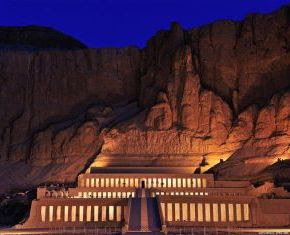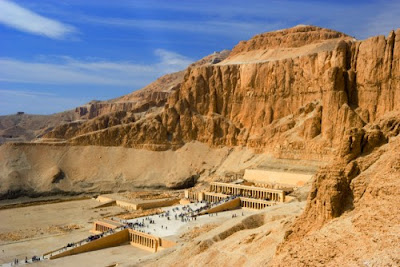he female mummy of Hatshepsut, Egypt's greatest woman ruler
Archaeologists today used a missing tooth to positively identify the mummy of Hatshepsut, Egypt's greatest woman pharaoh who reigned more than 3,000 years ago.
Zahi Hawass, Egypt's foremost archaeologist who led the research, said: "This is the most important discovery in the Valley of the Kings since the discovery of King Tutankhamun, and one of the greatest adventures of my life."
Hatshepsut ruled over Egypt, the most advanced civilisation in the world, for about 15 years (1473-58BC) and was only the second woman known to have assumed the throne.
She was the daughter of Tuthmosis I and married her half-brother Tuthmosis II. When her husband/brother died, she ruled as regent on behalf of his infant son Tuthmosis III, but effectively took over the throne.
Depictions of her illustrate the change of status, showing her in the traditional regalia, the royal head-covering known as the nemes headdress and false beard.
After her death Tuthmosis III took steps to erase all traces of her, archaeologists now believe in order to remove the female interruption in the male Tuthmosis lineage.
Statues of her were torn down, monuments defaced and her name scratched from the records.
In particular, her mummy went missing, a puzzle that has troubled Egyptologists for more than a century.
The British archaeologist Howard Carter discovered Hatshepsut's tomb while excavating at the Valley of the Kings in 1902. When he properly explored the tomb in 1920, two years before his famous discovery of King Tutankhamun's tomb, Mr Carter found two sarcophagi, one for Hatshepsut and the second for her father, but both were empty.
Speculation about the riddle has, for years, focused on a separate tomb now known as KV60, which Mr Carter found and opened in the spring of 1903.
Inside he found coffins of mummified geese, which he removed, and the partially disturbed and decaying coffins of two women lying side by side. One bore the inscription of Sitre-In, Hatshepsut's wet nurse, the other was anonymous.
As the tomb was not royal it received little attention until the Egyptologist Donald Ryan reopened it in 1989. The sarcophagus marked with the name of the wet nurse was taken to Cairo museum, and the second unnamed sarcophagus remained behind.
Mr Hawass decided to re-investigate the mystery surrounding Hatshepsut for a television special to be aired by the Discovery network and his team removed the second sarcophagus to Cairo for a CT scan.
"That is the only mummy I have removed from the Valley of the Kings," he said.
The scan revealed that this mummy was an obese woman between the ages of 45 and 60 who had bad teeth. She also suffered from cancer, evidence of which can be seen in the pelvic region and the spine.
In search of more clues, Mr Hawass suggested a CT scanner be used to examine artefacts associated with the queen. One of those was a small wooden box that bore the cartouche, or royal seal, of Hatshepsut and contained a liver.
Embalmers typically eviscerated the dead before embalming them but preserved the organs in jars and boxes.
The CT scan also revealed a tooth in the box. Mr Hawass called in a dentist, Galal El-Beheri from Cairo University, who studied the scans of the tooth and of several female mummies.
"Not only was the fat lady from KV-60 missing a tooth but the hole left behind and the type of tooth that was missing were an exact match for the loose one in the box," Mr Hawass said.
The exact dimensions of teeth are unique to each mouth. The molar tooth in the box fits within a fraction of a millimetre with the space of the missing molar in the mouth of the mummy. The minuscule difference could be due to erosion of the gums after the tooth was extracted.
"The discovery of the Hatshepsut mummy is one of the most important finds in the history of Egypt," Mr Hawass said. "Her reign during the 18th dynasty of ancient Egypt was a prosperous one, yet mysteriously she was erased from Egyptian history. Our hope is that this mummy will help shed light on this mystery and on the mysterious nature of her death.
Archaeologists today used a missing tooth to positively identify the mummy of Hatshepsut, Egypt's greatest woman pharaoh who reigned more than 3,000 years ago.
Zahi Hawass, Egypt's foremost archaeologist who led the research, said: "This is the most important discovery in the Valley of the Kings since the discovery of King Tutankhamun, and one of the greatest adventures of my life."
Hatshepsut ruled over Egypt, the most advanced civilisation in the world, for about 15 years (1473-58BC) and was only the second woman known to have assumed the throne.
She was the daughter of Tuthmosis I and married her half-brother Tuthmosis II. When her husband/brother died, she ruled as regent on behalf of his infant son Tuthmosis III, but effectively took over the throne.
Depictions of her illustrate the change of status, showing her in the traditional regalia, the royal head-covering known as the nemes headdress and false beard.
After her death Tuthmosis III took steps to erase all traces of her, archaeologists now believe in order to remove the female interruption in the male Tuthmosis lineage.
Statues of her were torn down, monuments defaced and her name scratched from the records.
In particular, her mummy went missing, a puzzle that has troubled Egyptologists for more than a century.
The British archaeologist Howard Carter discovered Hatshepsut's tomb while excavating at the Valley of the Kings in 1902. When he properly explored the tomb in 1920, two years before his famous discovery of King Tutankhamun's tomb, Mr Carter found two sarcophagi, one for Hatshepsut and the second for her father, but both were empty.
Speculation about the riddle has, for years, focused on a separate tomb now known as KV60, which Mr Carter found and opened in the spring of 1903.
Inside he found coffins of mummified geese, which he removed, and the partially disturbed and decaying coffins of two women lying side by side. One bore the inscription of Sitre-In, Hatshepsut's wet nurse, the other was anonymous.
As the tomb was not royal it received little attention until the Egyptologist Donald Ryan reopened it in 1989. The sarcophagus marked with the name of the wet nurse was taken to Cairo museum, and the second unnamed sarcophagus remained behind.
Mr Hawass decided to re-investigate the mystery surrounding Hatshepsut for a television special to be aired by the Discovery network and his team removed the second sarcophagus to Cairo for a CT scan.
"That is the only mummy I have removed from the Valley of the Kings," he said.
The scan revealed that this mummy was an obese woman between the ages of 45 and 60 who had bad teeth. She also suffered from cancer, evidence of which can be seen in the pelvic region and the spine.
In search of more clues, Mr Hawass suggested a CT scanner be used to examine artefacts associated with the queen. One of those was a small wooden box that bore the cartouche, or royal seal, of Hatshepsut and contained a liver.
Embalmers typically eviscerated the dead before embalming them but preserved the organs in jars and boxes.
The CT scan also revealed a tooth in the box. Mr Hawass called in a dentist, Galal El-Beheri from Cairo University, who studied the scans of the tooth and of several female mummies.
"Not only was the fat lady from KV-60 missing a tooth but the hole left behind and the type of tooth that was missing were an exact match for the loose one in the box," Mr Hawass said.
The exact dimensions of teeth are unique to each mouth. The molar tooth in the box fits within a fraction of a millimetre with the space of the missing molar in the mouth of the mummy. The minuscule difference could be due to erosion of the gums after the tooth was extracted.
"The discovery of the Hatshepsut mummy is one of the most important finds in the history of Egypt," Mr Hawass said. "Her reign during the 18th dynasty of ancient Egypt was a prosperous one, yet mysteriously she was erased from Egyptian history. Our hope is that this mummy will help shed light on this mystery and on the mysterious nature of her death.




Comments
Post a Comment